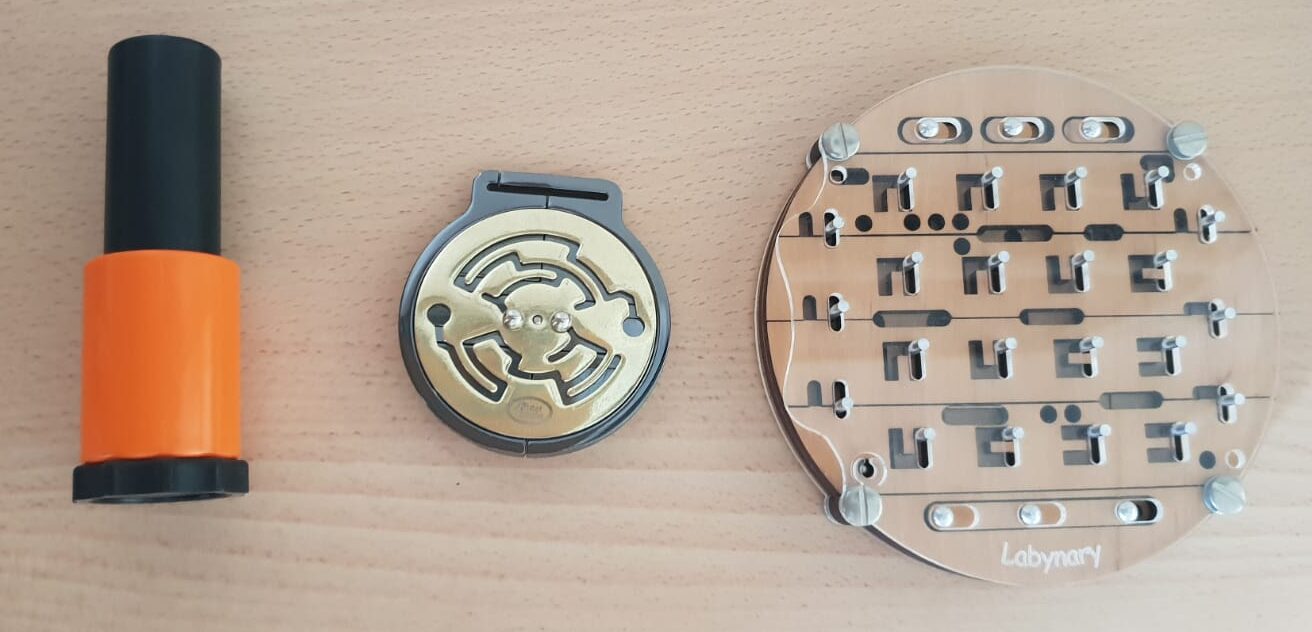Did you ever get lost?
In maze puzzles you will, many more times.
Don’t lose your way in the blog – read the first post in the guide.
If you did so already – then you’re set to learn about maze puzzles. Which is amazeing, because in these puzzles you will:
Get out of your comfort zone;
Take planned risks;
Stay concentrated for a long time;
Ignore your vision and spark your imagination;
Solve them as a part of another puzzle.
Mazes are great puzzles for the novice wanderer, as they are simple enough to understand and hard enough to be a challenge.
As in all puzzles, abstain from using force, as it may damage them.
Quick Navigation
What to look for?
There are basic mechanics you can expect in mazes:
Gravity – The puzzle has the same gravity as we do! A large part of the mazes require you to tilt them. Especially when there’s a small ball bearing inside.
Ball Bearings – A common mechanic in mazes. A ball bearing navigates inside the maze – it can be the navigating object or even some kind of obstacle or red herring.
Pins – Sometimes, the object navigating the maze is static, while the maze itself is moving around it. It can be a pin or a dent the maze moves on.
Traps – In harder mazes there are alluring traps you’ll need to dodge. If you get stuck there, it may be hard to go back.
Dynamic Mazes – Some mazes move around. In a moving maze we’ll need to build our way out. This combines more elements in the puzzle. It can be a path that appears at will, or even part of the maze on a moving strip.
Dexterity – Many mazes will require dexterity too. I know, there’s already a puzzle type for this – but this mechanic is surprisingly common in mazes, even unintendedly. Cool combo.
At the start of the post, in the right of the picture, you’ll see a plate with the writing “Labynary”. This is a genious maze designed by Jean Claude Constantin. It has some strips that need to be moved sequentially in order to build a path for a ball bearing, through which it’ll move using gravity. There are also some traps on the way – actually, there are multiple exits from the maze but some of them cannot be accessed.
Maze Sub-Types
Open Maze
You see the maze, you see the ball, you see them all. Navigation is the challenge.
In open mazes, expect the maze to contain more problems than just the navigation – it might be very complex, or take elements from other puzzle types.
Plan ahead or go straight in – in the end, your ability to exit mainly depends on your navigation skills.
Here’s an interesting open maze to get you started.
Hidden Maze
Imagine you’re walking in a dark castle, looking for a way out. You can count the steps in each direction you go or touch the walls, whatever suits you best – it’s intense either way.
How do you find your way inside a hidden maze? Using touch and imagination. You can feel the maze, slowly building it in your mind. You’ll eventually “see” more and more of it.
You can also draw a map of the maze, to help remember how it looks like.
How does a hidden maze look like? In the left of the pic at the top of the post, there’s a puzzle called Dael o Ring. A maze is hidden inside the orange ring, while the black cylinder has a small dent, locking the ring. The goal is to navigate the maze on this small dent until you can completely remove the ring.
In the first post of the guide I’ve talked about Inside3, a hidden maze with a travelling ball bearing. The catch there is that it comes with a map on the front of the puzzle, and you need to use it to advance.
In a hidden maze you need to turn on your imagination and endurance. It really is a challenge for your mind.
Combination Maze
If you mix between Maze and Combination puzzles – you’ll get a Combination Maze.
The plate in the picture, Labynary – is a Combination Maze.
Combination Mazes, unlike usual mazes, aren’t ready for a full solution – you need to build your path yourself, if you want to get to the end.
Imagine you got a building kit. You are told to build a maze with it. There are so many possibilities, but the maze must be solvable.
And don’t forget you have to actually solve it as well.
A Combination Maze is a good challenge for those who like both puzzle categories. To solve such a maze you’ll quite some time, and you can do it gradually – in each sitting you can build a new part and takea a break. A neat method for those who like to solve here and there, or those who like gradual, steady progress.
The puzzle in the middle of the picture, Medallion, is a Combination Maze. In the pic you can see a metallic plate with 2 pins. The other side has the same plate and pins, but with a different path in the plate.
What’s interesting is that each pin is connected to the pin on the other side, and the plate on each side connects the movements of the pins on each side. This way all the pins are interconnected and you must find the right combination to progress the pins through the maze.
Four mazes need to be navigated at the same time.
Two or Three?
One element in a a maze will define how much spatial thinking will need to be used – the number of dimensions.
In two-dimensions it’s easier for us to imagine the maze.
In three-dimensional mazes, we’ll need to up our spatial thinking game.
In four-dimensional mazes, the puzzle will shift through time and become a duck.
In fIvE-dIMenSiONs, 42.
I prefer three dimensional mazes because they challenge my imagination. Whatever you choose, there’s no correct answer but your own passion.
Try Them!
Did you find your favorite maze type? Try it.
I’ve spread some links for good puzzles of each category. Before you ask – Labynary is a good puzzle too – but brutal as well. Starting with it may be counterproductive for you. Save the fun for later!
This post was about the first out of seven general categories of mechanical puzzles.
Did you find your favorite category? Awesome. Now all you need is to find the puzzle you want in one of the best online stores.
Didn’t find your favorite? No problem. You can go back to the first and second overview posts and click on the puzzle category titles to learn more about it, when the posts about them become available.
– Challenge yourself.





One Reply to “Mechanical Puzzles – the Ultimate Guide : Mazes”
Comments are closed.